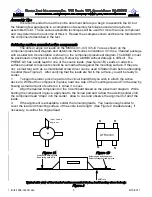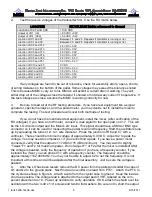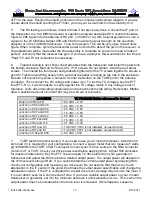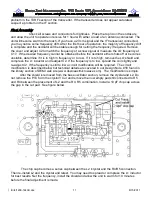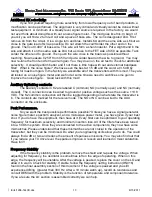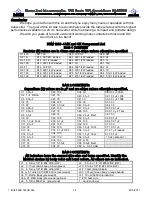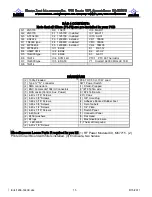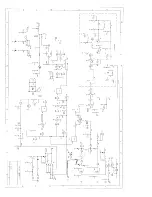
/Kits/1296-144CK.doc
9
8/15/2011
2.
Test the receive voltages of the transverter first. Use the RX matrix below.
LOCATION
RX VOLTAGE Matrix referenced to Ground
Junction of C47 and C48
+13.8 VDC
Output of VR1 (+9)
+9.0 VDC
±
0.2V
Output of VR4 (C66)
+5.0 VDC
±
0.2V
Junction of IC1 and C7
Between 1.5 and 2.5. Depends if Oscillator is running or not
Junction of IC1 and C9
Between 3.5 and 2.5. Depends if Oscillator is running or not
Junction of IC2 and C12
2.5 VDC
±
0.3V
Junction of IC2 and C13
3.5 VDC
±
0.5V
Junction of IC3 and C13
2.5 VDC
±
0.3V
Junction of IC3 and C16
5.0 VDC
±
0.5V
Junction of IC5 and C29
2.8 VDC
±
0.3V
Junction of IC5 and C31
5.0 VDC
±
0.3V
Junction of IC10 and F5
0 VDC
Junction of IC10 and C70
5.0 VDC
±
0.3V
Junction of Q3 and R30
3.8 VDC
±
0.5V
Junction of Q2 and C6
8.5 VDC
±
0.5V
Junction of Q1 and C3
9.0 VDC
±
0.5V
If any voltages are found to be out of tolerance, check for assembly errors, opens, shorts,
or wiring mistakes on the bottom of the pallet. Some voltages may exceed the tolerances listed.
This is because MMIC’s vary lot to lot. MMIC’s will exhibit a current drain if working. They will
either drop all of the voltage across the resistor if shorted or not draw any current if inoperative. If
the test voltages are close, assume the MMIC is working correctly for now.
3.
Be sure to read all of the RF testing procedure. If you have test equipment like a signal
generator, spectrum analyzer, and mw power meter, you may decide not to install the mixer to
complete the testing. The test procedure will cover both methods of testing.
If you do not have the mentioned test equipment, install the mixer, (after verification of the
RX voltages). If you have an mW meter, connect a coax pigtail to the open pad on C17. This will
be the LO circuit’s output and the Mixer’s LO input. This pigtail should have a SMA or BNC type
connector so it can be used for measuring the power level and frequency. Start the oscillators tune
up by spreading the turns of L1 to 1 wire diameter. Probe the junction of R6 and C7 with a
voltmeter. There should be minimum voltage of approximately 0.4 VDC. Adjust C2 to peak the
voltage. You may need to compress L1 if you cannot find a peak. If you have a power meter
connected, verify that the output is +17 dBm (+15 dBm minimum). You may want to slightly
“Tweak” F1 and F2 for maximum power. Do not adjust F1 or F2 after the mixer is installed! After
the voltage is peaked, verify the frequency of operation if you have a frequency counter. If you
installed the mixer, you can probe C17 with a frequency counter. The frequency should be
approximately 1152.000 MHz. You may not be able to adjust C2 to net the frequency. It is not
important at this time and will be adjusted after the final assembly. Just be sure the voltage is
peaked.
4.
After the LO has been tested, remove the DC power from the pallet and solder the cans of
Q1 and Q2 to the ground plane. Next find and un-solder one lead from PTC1. Attach the PTC to
the crystal as shown in figure 6. Attach a wire from the crystal case to ground. Keep the lead as
short as possible. The voltage lead is attached to the output pad of VR1, labeled on the com-
ponent placement as +9. Power up oscillator to verify operation. If OK, attach the shield over the
oscillator with the two 4-40 x 1/4” screws and two #4 flat washers. Be sure not to short the output
Summary of Contents for 1296-144 CK
Page 16: ......



